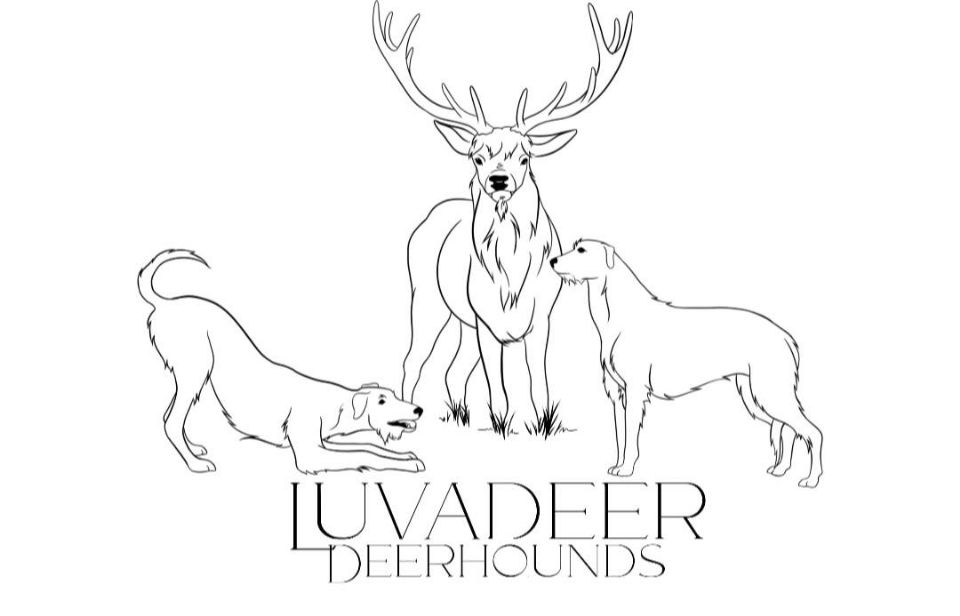About Deerhounds
HISTORY OF THE BREED
The origin of the Deerhound breed is of such antiquity and the earliest names bestowed
on it so inextricably mixed that no sound conclusion can be arrived at as to whether
the Deerhound was at one time identical with the ancient Irish Wolf dog and, in the
course of centuries, bred to a type better suited to hunt deer, or whether, as some
writers claim, he is the descendant of the hounds of the Picts. Very early descriptive
names were used to identify the purpose of the dog rather than to identify species.
We find such names as “Irish Wolf Dog,” “Scotch Greyhound,” “Rough Greyhound,”
“Highland Deerhound.” Dr. Ciaos, in his book Of Englished Doges (1576) speaking of
Greyhounds, relates: “Some are of the greater sorter, some of a lesser; some are
smoothed skinned and some curled, the bigger therefore are appointed to hunt the
bigger beasts, the buck, the hart, and the doe.”
All this is relatively unimportant when we can definitely identify the breed as Deerhounds
as early as the sixteenth and seventeenth centuries. From there on the term Deerhound
has been applied to the breed, which of all dogs has been found best suited for the
pursuit and killing of the deer.
At all times great value has been set on the Deerhound. The history of the breed
teems with romance increasing in splendour right down through the Age of Chivalry
when no one of rank lower than an earl might possess these dogs. A leash of
Deerhounds was held as the fine whereby a noble lord condemned to death might
purchase his reprieve. Records of the middle Ages allude repeatedly to the delightful
attributes of this charming hound, his tremendous courage in the chase, and his
gentle dignity in the home.
So highly has the Deerhound been esteemed that the desire for exclusive ownership
has at many times endangered the continuance of the breed. As the larger beasts of
the chase became extinct, or rare, in England and Southern Scotland, the more
delicate, smooth Greyhound took the place of the larger Deerhound. The Highlands
of Scotland, last territory wherein the stag remained numerous in a wild state, became,
as might be expected, the last stronghold of this breed. Here again the Highland
Chieftains assumed exclusive proprietorship to such an extent that it was rare to find
a good specimen south of the River Forth. So severely was this policy pursued that in
1769 the breed physically and numerically ran very low. This, of course, must be
attributed in a great measure to the collapse of the clan system after Culloden 1745.
It was not until about 1825, when the restoration of the breed was undertaken very
successfully by Archibald and Duncan McNeill (the latter afterwards Lord Colonsay),
that the Deerhound regained his place of pre-eminence and former perfection. The
First World War, in later times, had considerable effect on the breed when so many of
the large estates in Scotland and England were broken up. Although this “Royal Dog
of Scotland” is represented at English shows in good numbers and to a considerable
extent at shows in the Eastern States of the United States of America, the Deerhound
remains a rare dog of such historical interest and character that ownership should
give anyone great pride of possession.
The high valuation of the Deerhound is not the result of rarity so much as the fact
that as a hunter he is pre-eminent, with a high aggregate of desirable characteristics.
He has a keen scent, which may be used in tracking, but it is that combination of
strength and speed necessary to cope with the large Scottish deer (often weighing
250 pounds) that is most valued. The hounds are usually hunted singly or in pairs.
Centuries of hunting as the companions and guards of Highland Chieftains have
given the Deerhound an insatiable desire for human companionship. For this reason
the best Deerhounds are seldom raised as kennel dogs. In character the Deerhound
is quiet and dignified, keen and alert, and although not aggressive, has great
persistence and indomitable courage when necessary. While it might savour of boasting
to claim that the Deerhound of today is identical with the dog of early history,
descriptions of which are mostly legendary, it is nevertheless a well-established fact
that in type, size, and character he closely conforms to authentic records of the
eighteenth and nineteenth centuries.
As a companion the Deerhound is ideal, being tractable and easy to train and
possessing the most dependable loyalty and utmost devotion to his master. The most
authentic and complete work on the breed is “Scotch Deerhounds and their Masters”
written by George Cupples. Scrope has also written much about the Deerhound in
“Days of Deerstalking” and other works. The best descriptions of the breed are found
in nineteenth-century British dog books.
The grace, dignity and beauty of the Deerhound have been faithfully depicted in
many of Landseer’s paintings and drawings, and Sir Walter Scott, who owned the
famous Deerhound Maida, makes many enthusiastic allusions to the breed, which
he describes as “The most perfect creature of Heaven.”
“We must try and keep the Deerhound a rugged, rough-coated, well-muscled animal
and not to allow it to be ruined by shows, as has happened to so many breeds, which
have become too refined, too stripped and over-groomed”.
Taken From The ANKC Website
